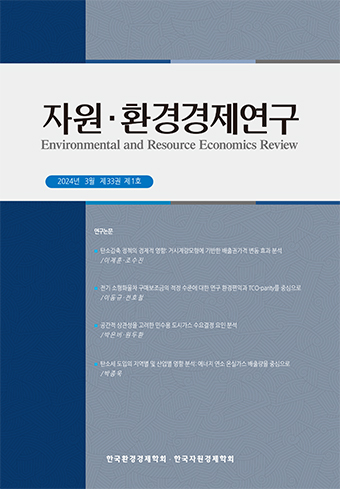Research Paper
Abstract
References
Information
This study analyzes the purchase subsidy for electric light-duty vehicles in terms of environmental benefits and total cost of ownership(TCO). For the environmental benefits, we considered the emissions from the power generation mix and reflected the change in efficiency of electric vehicles according to the temperature distribution. The environmental benefits of driving electric vehicles were estimated to be between KRW 2.2 million and KRW 5.3 million. Also, the TCO of electric vehicles compared to diesel vehicles under the current purchase subsidy was estimated to be about KRW 3.6 million lower for business use and about KRW 6.6 million lower for non-business use. These results imply that it is reasonable to lower the unit price of the purchase subsidy even within the same budget. Moreover, the remaining budget could be better spent on upgrading the charging infrastructure, which would reduce the inconvenience of charging for potential buyers.
본 연구는 전기 소형화물차에 대한 구매보조금이 환경편익의 측면과 총보유비용 동등성 측면에서 볼 때 적정한 수준인지에 대하여 분석하였다. 환경편익에 대해서는 발전믹스에 따라 발생하는 환경오염물질 배출량을 고려하였으며, 기온분포에 따른 전기차의 효율변화도 반영하였다. 소형화물차의 경우, 경유차 대신 전기차를 운행함에 따른 환경편익은 차량의 총운행기간에 걸쳐 217~530만 원 수준으로 추정되었다. 또한, 현행 구매보조금 제도하에서 경유차 대비 전기차의 총보유비용은 사업용은 약 360만 원, 비사업용은 약 660만 원 낮은 것으로 추산되었다. 즉, 환경편익의 관점에서든 총보유비용의 관점에서든 보다 효율적으로 재정을 활용하고자 한다면 같은 예산이라도 전기 소형화물차에 대한 구매보조금 단가를 낮추는 것이 합리적이다. 그 대신 남은 예산은 화물차 전용 충전기의 확보와 같이 충전인프라를 고도화하는 데에 좀 더 집중한다면 잠재적인 구매자들의 금전적인 부담뿐만 아니라 충전 관련 불편함까지 줄여 전기 소형화물차 보급에 더 비용효과적일 것으로 판단된다.
- 공공데이터 포털, https://www.data.go.kr/data/15039553/fileData.do#tab-layer-openapi (접속일: 2022.6.1.)
- 곽재진‧김성수, “국내 전기차 수요 분석 및 예측”, 「한국SCM학회지」, 제20권 제1호, 2020, pp. 24~35. 10.25052/KSCM.2020.05.20.1.24
- 관계부처 합동, “제4차 친환경자동차 기본계획(2021~2025)”, 2021.
- 국민권익위원회, “국민권익위, 전기‧수소차 관련 불편사항 민원 빅데이터를 통해 관계기관과 함께 개선한다!”, 보도자료, 2021.6.15.
- 기상청 기상자료포털, https://data.kma.go.kr/cmmn/main.do (접속일: 2022.6.1.)
- 기아 홈페이지, https://www.kia.com/kr/vehicles/bongo3/features.html (접속일: 2022.6.1.)
- 김도원‧진태영, “전기차 온실가스 감축잠재량 계산을 위한 시간대별 배출계수 추정”, 「환경정책」, 제30권 제1호, 2022, pp. 201~229. 10.15301/jepa.2022.30.1.201
- 김두형, “환경친화적인 자동차세제 도입방안”, 「조세법연구」, 제17권 제2호, 2011, pp. 207~249. 10.16974/stlr.2011.17.2.007
- 김용기‧정장훈, “친환경차 구매 보조금을 고려한 수소연료전기차와 내연기관차 구매 비용의 경제성 분석: 서울시를 중심으로”, 「환경정책」, 제29권 제4호, 2021, pp. 221~242. 10.15301/jepa.2021.29.4.221
- 신승진‧허성호‧박지영, “화물자동차 개별 특성을 고려한 무공해 차량 전환의 환경성 분석”, 「교통연구」, 제28권 제2호, 2021, pp. 1~17.
- 신진수, “소비자 선호도를 이용한 전기자동차 확산 예측”, 서울대학교 공학석사학위논문, 2018.
- 안소은 외, “PM2.5 조기사망의 대기오염물질‧오염원별 피해비용 산정”, KEI 포커스, 제7권 제6호, 2019.
- 유종훈‧김후곤, “손익분기점 분석을 이용한 전기차의 보조금 정책 연구”, 「에너지공학」, 제20권 제1호, 2011, pp. 54~62. 10.5855/ENERGY.2011.20.1.054
- 이동규 외, “수송용 에너지 상대가격 합리적 조정방안 연구”, 기획재정부‧국토교통부‧산업통상자원부‧환경부‧한국조세재정연구원, 2017.
- 이동규 외, “발전용 에너지 제세부담금 체계 합리적 조정방안 연구”, 기획재정부‧산업통상자원부‧환경부‧한국조세재정연구원, 2018.
- 이동규‧최준욱, “고효율 차량 구입을 유도하기 위한 세제개편 방안 연구: 하이브리드 차량을 중심으로”, 「에너지경제연구」, 제17권 제2호, 2018, pp. 115~146.
- 임병인, “자동차 관련세제 개편방안 연구”, 「경제연구」, 제28권 제2호, 2010, pp. 29~55.
- 전호철, “전기자동차 보급에 따른 지역간 오염물질 및 온실가스 배출 영향 분석”, 한국환경정책‧평가연구원, 2017.
- 전호철, “에너지 전환정책에 따른 전기자동차의 환경편익 추정연구”, 「자원‧환경경제연구」, 제28권 제2호, 2020, pp. 307~326.
- 차지비, https://www.chargev.co.kr/customer-support/charging_fee (접속일: 2022.6.1.)
- 한국교통안전공단, “2020 자동차주행거리통계”, 2021.
- 한국석유공사 오피넷, https://www.opinet.co.kr/ (접속일: 2022.6.1.)
- 한국에너지공단 자동차 에너지소비효율 및 등급 홈페이지, https://bpms.kemco.or.kr:444/transport_2012/main/index.aspx (접속일: 2022.6.1.)
- 한국전력공사, “한국전력통계 제91호”, 2022.
- Bai, B., Y. Wang, S. Xiong, and X. Ma, “Electric vehicle-attributed environmental injustice: Pollutant transfer into regions with poor traffic accessibility,” Science of The Total Environment, Vol. 756, 2021, p. 143853. 10.1016/j.scitotenv.2020.143853 33293095
- Holland, S. P., E. T. Mansur, and A. J. Yates, “Are There Environmental Benefits from Driving Electric Vehicles? The Importance of Local Factors,” American Economic Review, Vol. 106, 2016, pp. 3700~3729. 10.1257/aer.20150897
- Holland, S. P., E. T. Mansur, N. Z. Muller, and A. J. Yates, “Distributional effects of air pollution from electric vehicle adoption,” Journal of the Association of Environmental and Resource Economists, Vol. 6(S1), 2019, pp. S65~S94. 10.1086/701188
- Holland, S. P., E. T. Mansur, N. Z. Muller, and A. J. Yates, “The environmental benefits of transportation electrification: Urban buses,” Energy Policy, Vol. 148(PA), 2021. 10.1016/j.enpol.2020.111921
- Interagency Working Group on Social Cost of Greenhouse Gases (IWG), “Technical Support Document: Social Cost of Carbon, Methane, and Nitrous Oxide; Interim Estimates under Executive Order 13990, ” February, 48, 2021.
- International Energy Agency (IEA), “Net Zero by 2050: A Roadmap for the Global Energy Sector,” 2021.
- Ji, S., C. R. Cherry, W. Zhou, R. Sawhney, Y. Wu, S. Cai, S. Wang, and J. D. Marshall, “Environmental Justice Aspects of Exposure to PM2.5 Emissions from Electric Vehice Use in China,” Environmental Science and Technology, Vol. 49, 2015, pp. 13912~13920. 10.1021/acs.est.5b04927 26509330
- Parry, I., D. Heine, E. Lis, and S. Li, “Getting Energy Prices Right: From Principles to Practice,” IMF, 2014.
- Ricardo-AEA, “Update of the Handbook on External Costs of Transport,” 2014.
- World Meteorological Organization (WMO), “The state of the global climate 2021,” 2021.
- Yuksel, T., and J. J. Michalek, “Effects of Regional Temperature on Electric Vehicle Efficiency, Range, and Emissions in the United States,” Environmental Science & Technology, Vol. 49, 2015, pp. 3974~3980. 10.1021/es505621s 25671586
- Publisher :Environmental and Resource Economics Review
- Publisher(Ko) :자원 · 환경경제연구
- Journal Title :자원·환경경제연구
- Journal Title(Ko) :Environmental and Resource Economics Review
- Volume : 33
- No :1
- Pages :33-57
- DOI :https://doi.org/10.15266/KEREA.2024.33.1.33



 자원·환경경제연구
자원·환경경제연구






